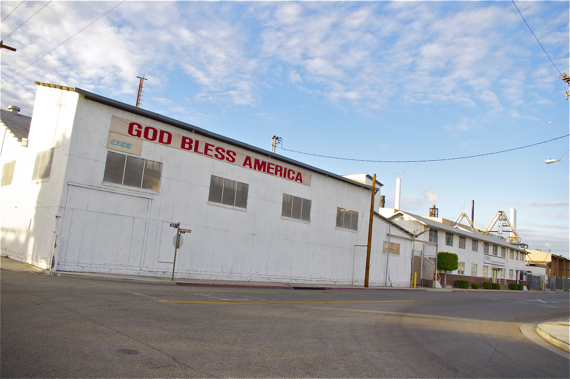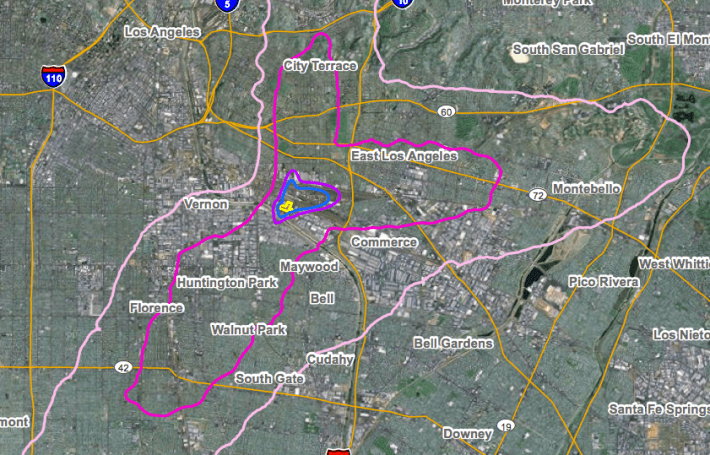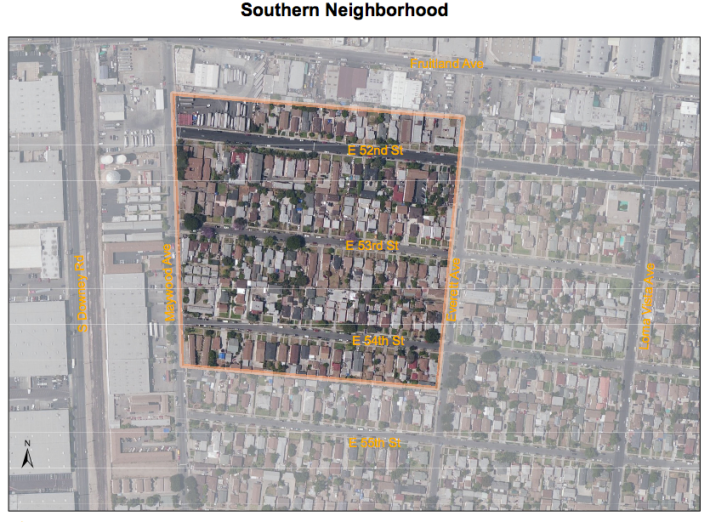Victory in Our Time: Exide Plant to Close for Good, First Phase of Clean-Up of Site to Begin Immediately
5:59 PM PDT on March 12, 2015

As news began to trickle out Wednesday night that, under an agreement with the U.S. Attorney’s Office, embattled lead-acid battery recycler Exide Technologies will be forced to permanently shutter its Vernon plant, hope seemed to have finally been restored to those who have spent years clamoring for environmental justice.
In the 15 years since Exide took over operations at the Vernon site, it has repeatedly violated air quality and other standards by improperly storing lead-acid batteries, contaminating a drainage channel with lead, failing to clean up public areas it contaminated around the plant, spilling approximately 1136 lbs. of lead into the watershed (between 2003 and 2006), exceeding airborne lead emissions multiple times (including during the period it was closed for upgrades last year), not repairing degraded pipes carrying up to 310,000 gallons of contaminant-laden wastewater a day, and, most recently, storing "contaminated sludge in tanks that [it] is not authorized to operate,” failing to sufficiently protect against spills of hazardous waste, and “fail[ing] to minimize the possibility of any unplanned sudden or non-sudden release of hazardous wastes or hazardous waste constituents to air, soil, or surface water."
Most egregiously, Exide managed to accomplish all of these terrible feats while operating on an interim permit, something many in the surrounding communities have long viewed as negligence on the part of the Department of Toxic Substances Control (DTSC), the South Coast Air Quality Management District (AQMD), and other relevant authorities.
Exide didn't even file its first application for a formal operating permit until 2006. Nor was it hit with any real financial penalties until very recently. By the DTSC's own admission, between 1990 and 2015, it only levied a total of about $2 million in penalties against Exide and its predecessors in 10 separate enforcement actions. A $1.3 million fine -- the bulk of that total -- was not levied against Exide until November, 2014.
The agreement to close the plant will therefore be a largely welcome one for most in the surrounding communities (minus, of course, the 130 employees who have now permanently lost their jobs).
But it doesn't mean we're quite out of the woods, yet.

First, despite Exide's long history of violations, the closure agreement allows it to avoid prosecution in the criminal investigation the Attorney's Office launched into its emissions history and illegal storage of hazardous materials.
This may be a major oversight.
Exide had been notified of the DTSC's intention to deny it an operating permit on February 26 -- well ahead of the formalization of its agreement with the Department of Justice (DOJ). Meaning that the plant would have been forced to close regardless of the outcome of the criminal investigation.
By signing on to the federal agreement -- an agreement the DOJ drew up without consulting the DTSC -- Exide effectively avoids further exploration into the extent of what, if any, criminal wrongdoing it is responsible for and limits the ability of affected residents, the city, or the state to seek redress (outside of existing agreements) for any resulting damages.

Second, both Exide's ability and its willingness to clean up its own mess are rather suspect.
Thursday's DTSC press release about the closure cites concerns regarding Exide's ability to ensure adequate funding for the safe closure of the facility and the complete cleanup of lead contamination in the surrounding communities as being key to their decision to deny Exide a formal permit.
As DTSC Director Barbara Lee reiterated during a press call Thursday afternoon, given that it is unclear what Exide's status will be when it emerges from bankruptcy, those concerns will continue to remain front and center. Not only have the bankruptcy proceedings tied up Exide's funds for a few years now, but Exide has not hesitated to use the proceedings to its financial advantage. Notably, it required that anyone submitting personal damage claims (e.g. excessive lead in blood, other health issues) do so by the end of January of 2014, well before any of the free blood tests it agreed to pay for could actually be administered to residents of communities affected by lead emissions. And while Exide did comply with the November 2014 order that it put $2.75 million into a closure financial assurance fund and $3 mil. into a trust fund for residential clean-ups, those funds represent just a fraction of the approximately $50+ mil. the DTSC estimates the final clean-up will eventually cost.
Even assuming Exide does have sufficient funds to conduct a clean-up, follow-through may still be a significant issue.
Last June, the DTSC's assessment of Exide's third application for a formal operating permit indicated they had little confidence in Exide's ability to perform even the most basic of tasks properly, such as conducting sampling or cataloging how much hazardous waste was on site. Specifically, they declared that Exide's application:
- Fails to provide an accurate cost estimate to ensure Exide can safely clean up the site after it has permanently ceased operations. Specifically, the application fails to accurately describe actions needed to clean up lead contamination throughout the facility, demolish structures, and remove contaminated soil underneath the facility;
- Fails to accurately describe the amount of lead-contaminated waste that needs to be safely removed from the site for treatment and disposal when the facility permanently closes;
- Fails to include a safety assessment of all tanks that hold waste, including tanks that hold acidic hazardous wastes that could overflow during an earthquake;
- Fails to describe all rooms where waste is handled so that it can be safely managed; and
- Fails to describe the correct sampling needed to characterize toxic contamination that must be cleaned up after the facility is permanently closed.
The DTSC subsequently sent Exide a Notice of Deficiency that carefully detailed its concerns with the application and requested that Exide adjust and resubmit the application within 30 days. Even with that level of assistance, Exide struggled to comply, eventually requesting (and receiving) a substantial extension of the deadline.
Unfortunately, Exide's struggle to get its act together is not all that surprising.
As the good people of a number of communities across the U.S. can attest, Exide has quite a legacy of inflicting environmental harm. In Frisco, Texas, where Exide was forced to shut down operations a little over two years ago, the post-closure clean-up of the area has been fraught with problems (including the disappearance of a bucket of potentially contaminated waste off the back of a truck) and concerns about whether Exide would continue to comply with the settlement agreement. Just last October, Frisco leveled fresh accusations that Exide was continuing to downplay the contamination at the former plant site in order to hurry the clean-up process along and minimize costs.
When asked about these failures and oversight mechanisms on the press call, Lee acknowledged Exide's poor track record, saying, "We have concerns."
She went on to cite a recent case in which the DTSC had required Exide to conduct additional sampling under the containment area at the plant only to find that contamination levels were much higher than Exide had previously estimated.
The DTSC, she reiterated, would continue to work closely with the AQMD, the County, and any other relevant authorities, as it has over the last year, to ensure that oversight and enforcement are sufficient. Moreover, she pointed out, by entering into a federal agreement, Exide had granted the DOJ the ability to bring any and all of the necessary resources to bear to ensure the clean-up is conducted properly during the next 10 years.
The first phase of the clean-up should begin immediately, she said. The clean-up, demolition, and removal of the existing plant structure should take between 19 and 22 months. During this time, Exide will be required to continue paying into a clean-up fund, studying the contamination levels at the site, and preparing plans for phase 2 of the process -- the decontamination of the site and surrounding areas.
Decontamination of residential areas will also continue during this period, Lee added, as will the study and planning for decontamination of residences that fall outside the two assessment areas (those areas pinpointed by emissions modeling as being most likely to have experienced lead contamination) currently undergoing testing and clean-ups.

Although Lee suggested planning for any residential clean-ups outside the boundaries of the existing assessment areas will take place on an accelerated schedule, she could offer no estimate of what that time-frame might be.
She also noted that it was important that the DTSC had recently secured a commitment from Exide to dedicate an additional $5 mil. to the $9 mil. already earmarked for residential clean-ups because, she felt, the clean-ups would "probably cost more than [$9 mil.]." The extra funds won't be handed over until 2018, but Lee believes there should be enough in the pot to ensure clean-ups can continue in the meanwhile.
Finally, Lee said she understood the skepticism observers might have, both regarding Exide and the ability of the DTSC to oversee the closure of the plant. Before 2013, the DTSC had stopped by to inspect Exide's operations, on average, once a year. Over the last year and a half, they ratcheted up their oversight and were on site once a month. Now, she has staff on site even more regularly and the DTSC is "fully committed," she said, "to the protection of public health and the environment."
The DTSC will make sure all of the agencies are working together to ensure Exide is complying with the law, she reiterated. "You can watch us going forward."
For more information on the DTSC's monitoring of Exide or to track the clean-up of residential areas, please visit their dedicated webpage here.
Sahra is Communities Editor for Streetsblog L.A., covering the intersection of mobility with race, class, history, representation, policing, housing, health, culture, community, and access to the public space in Boyle Heights and South Central Los Angeles.
Stay in touch
Sign up for our free newsletter
More from Streetsblog Los Angeles
Metro Board Funds Free Student Transit Pass Program through July 2025
Metro student free passes funded another year - plus other updates from today's Metro board meeting
Eyes on the Street: New Lincoln Park Avenue Bike Lanes
The recently installed 1.25-mile long bikeway spans Lincoln Park Avenue, Flora Avenue, and Sierra Street - it's arguably the first new bike facility of the Measure HLA era




